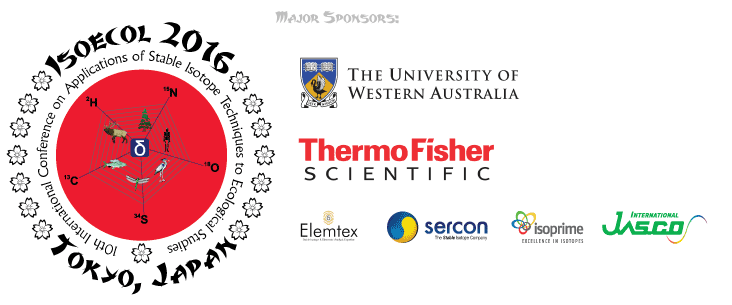We are delighted to confirm the following Keynote speakers will be attending IsoEcol 2016.
- Gabriel Bowen, University of Utah
- Yoshito Chikaraishi, JAMSTEC
- James Ehleringer, University of Utah
- Michael Richards, The University of British Columbia
Gabriel Bowen, University of Utah
Gabriel Bowen is an Associate Professor of Geology and Geophysics and member of the Global Change and Sustainability Center at the University of Utah, where he leads the Spatio-temporal Isotope Analytics Lab (SPATIAL) and serves as co-director of the SIRFER stable isotope facility. His research focuses on the use of spatial and temporally resolved geochemical data to study Earth systems processes ranging from coupled carbon and water cycle change in geologic history to the movements of modern and near-modern humans. He has coauthored more than 100 peer reviewed papers and book chapters, and his work has been supported by grants from the US National Science Foundation, other US government agencies, and private foundations. In addition to fundamental research, he has been active in developing cyberinformatics tools and training programs supporting the use of large-scale environmental geochemistry data across a broad range of scientific disciplines, including the waterisotopes.org and IsoMAP.org web sites and the Inter-University Training for Continental-scale Ecology training program (http://itce.utah.edu).
Generalizing the application of isoscapes in ecology: Thinking across scales and systems
Isotopic heterogeneity in the environment is the template on which ecological studies of resource use, movement, and mass and energy flow are based. This heterogeneity can be conceptualized as a multidimensional isotopic landscape, or isoscape, with dimensions of space, time, and substrate commonly describing the majority of the variation observed. Environmental isoscapes exist for a wide range of systems and substrates and over several orders of magnitude in spatial and temporal scale. Although they have been exploited in many ecological applications, consideration of the spatiotemporal structure of environmental isoscapes is often implicit in the analyses conducted. This presentation will explore ecologically relevant hydrogen and oxygen isoscapes spanning scales from thousands of kilometers to tens of centimeters. Data from each scale illustrates strong spatial and temporal structure that informs our understanding of isoscape-generating processes and provides a basis for predictive understanding of isotope distributions. In addition to the practical utility of such predictive isoscape models, the explicit decomposition of environmental isotope variation within the space-time-substrate reference frame elucidates potential opportunities and limitations of ecological applications. The isoscape framework is thus of general utility in the development and pursuit of isotope-based ecological research, as evidenced by a growing number and scope of studies leveraging this paradigm.
Yoshito Chikaraishi, JAMSTEC
Yoshito Chikaraishi is a Senior Scientist in the Department of Biogeochemistry at the Japan Agency for Marine-Earth Science and Technology (JAMSTEC). His research interests are
- an understanding of factors controlling molecular and stable isotopic compositions of organic compounds in nature, and
- development and application of new analytical methods for isotope analysis of organic compounds
More recently, he has employed Compound-Specific Isotope Analysis of Amino Acids (CSIA-AA) as a new method in ecological food web studies, particularly for understanding trophic linkages and energy flow among plant and animal species in ecosystem networks. He has demonstrated the high applicability of CSIA-AA for viewing food web structures in marine and terrestrial food webs and is dedicated to better understanding of isotopic discrimination mechanisms in auto- and heterotrophic organisms.
High-resolution food webs viewed via compound-specific isotope analysis of amino acids
For better understanding of trophic linkages and energy flow in complex networks of ecosystems, we have recently employed compound-specific stable isotope analysis (CSIA) of amino acids as a relatively new method. In particular, CSIA has been used to estimate trophic position (TP) among animal species, using the following equation:
TP = [(δ15NTr – δ15NSrc + β)/TDF] + 1
where δ15NTr and δ15NSrc denote stable nitrogen isotopic compositions of trophic and source amino acids (most commonly represented by glutamic acid and phenylalanine), respectively, β denotes the isotopic difference between trophic and source amino acids in primary producers (e.g., aquatic and terrestrial plants), and TDF denotes trophic discrimination factor at each shift in the trophic level. However, the validity of such estimates is highly dependent on the accuracy and consistency of both β and TDF values, which are not yet fully understood.
In this presentation, I would like to show the potential of the CSIA method to illustrate food web structure in natural ecosystems, and will discuss factors controlling the β and TDF values of amino acids, based on experimental results from a number of my own investigations and previously published literature.
 James Ehleringer, University of Utah
James Ehleringer, University of Utah
James Ehleringer is a Distinguished Professor of Biology at the University of Utah and director of Utah’s Global Change and Sustainability Center and the Stable Isotope Ratio Facility for Environmental Research. His research has spanned from ecological studies of natural and urban systems through atmospheric trace gas studies and forensic science. Throughout his academic career, Jim has also focused on creating the facilities and organizational structures to advance interdisciplinary science and provide new opportunities for others. He launched IsoForensics, a spinoff company focusing on applications of stable isotope analyses. Jim’s recent research projects have melded stable isotope analyses with process studies to understand carbon and water cycles, air quality in urban zones, humans and our foods, and biomarkers in climate studies.
Diet, location, travel, and socioeconomic status: what stable isotopes reveal about you
It is now well established that there are variations in the stable isotope abundances of light elements within our foods and our bodies and that these variations provide extremely useful information to anthropologists, biologists, ecologists, forensic scientists, and health scientists. While carbon, nitrogen, and sulfur isotope abundances have been applied to examine foods and reconstruct human dietary patterns, hydrogen and oxygen isotope abundances have been applied to examine human region-of-origin and travel movements. Over the last decade, we have witnessed a staggering expansion of stable isotope applications to understand the composition of our foods as well as humans as environmental recorders (through analyses of hair, teeth, bones, and fingernails). In this presentation, we first highlight some of that progress and then focus on three of several emerging frontiers. The first emerging frontier is glocalization and our food supply. That is, how does the global expansion of food products intersect with and adapt to the local cultures in which food is sold? Two global foods will highlight this glocalization process: hamburgers and soft drinks. A second frontier is dissecting observed variations of stable isotopes in humans to better understand the roles of both socioeconomic status and age in influencing dietary choices. Here we explore the interactions among wealth, the balance of plant versus animal proteins in our diets, and food production (commercial concentrated animal feeding operations to produce cheap food). A third emerging frontier is sequential fingernail analyses as a linear recorder of an individual’s diet and travel history. Collectively, these three emerging frontiers indicate vibrant and expanding opportunities for new insights into human behavior based on stable isotope observations.
Michael Richards, University of British Columbia
Professor Michael Richards (D.Phil. Oxford, MA, BA, Simon Fraser University) is an archaeological scientist who applies methods such as isotopic analysis to determine past human and animal diets and adaptations. His research interests include the evolution of human diets, developing new isotope systems for dietary and migration studies, and using isotope analysis to explore and catalogue the range and nature of human dietary adaptations throughout the Holocene. He has published over 200 research papers, including in the journals Nature, Science, and PNAS, and he has supervised over 50 graduate students and post-docs. He is a professor of Anthropology at Department of Anthropology, University of British Columbia in Vancouver, Canada and holds honorary research positions at the Max Planck Institute for Evolutionary Anthropology in Leipzig, Germany, and Durham University in the UK. He is a Fellow of the Society of Antiquaries of London, and a Fellow of the Royal Society of Canada.
An overview of the stable isotope evidence of human dietary adaptations over the past 30,000 years
In this paper I will review the work of my group and others on the C and N isotope measurements of archaeological human and animal bone collagen for reconstructing past human diets over the past 30,000 years. There are now significant numbers of measurements (i.e. over 50,000) of archaeological humans from around the world, and we are now able to begin looking for large-scale patterning in this dataset. For much of the time modern humans have existed we were hunter-gather-foragers, and for those archaeological contexts a stable isotope ecological approach works well to understand how humans adapted their diets in response to their ecosystems. However, at approximately 12,000 years ago (at the start of the Holocene) humans began to intensify the use of individual wild resources like marine foods and more dramatically alter their environments through the domestication of plants and animals. Archaeological human palaeodietary isotope studies then show that human diets are no longer predictable based on their local ecosystems and environments, as through time they increasingly rely on the foods they have domesticated, imported or transported as they move into new landscapes.
